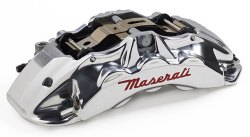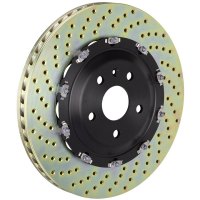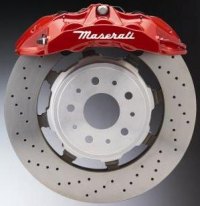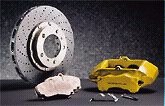|
AUTOZINE TECHNICAL SCHOOL
Brake Brake disc and caliper technology
Cast Iron Brakes There have been relatively few breakthroughs in brake disc and caliper technology during the past 20 to 30 years. Carbon-ceramic brakes aside, the most powerful disc brakes are still ventilated, cross-drilled and made of cast-iron. However, larger and larger wheels adopted on modern cars (now 20 or 21-inch items are not uncommon) enable larger discs as well, which account for improved stopping power. Larger brake discs need larger calipers to clamp them, of course. That's why many high-performance cars now employ large calipers with up to 6 pistons (aka "6-pot"), or even 8 pistons on some track cars. To cut unsprung weight, high-performance calipers are usually made of billet aluminum, which is machined from a solid block of aluminum. This single-piece structure, or so-called "monobloc", increases strength and cuts weight further.
Obviously, cast-iron disc is the heaviest part of the braking system – about 8 kg apiece or 32 kg per car, and this is unsprung weight, which worsens ride quality. Lotus used to adopt aluminum discs on its base Elise. Though light, they are less resistant to heat and fade because aluminum heats up and expands a lot more than iron under the same power dissipation, so they are not suitable for heavy duty use. Traditionally, cross-drill was the only way to cut weight from cast-iron brake disc. In recent years, manufacturers realized they can convert the bell (hub) to aluminum to save some weight, while keeping the outer disc in cast-iron so that not to affect the friction/thermal properties. To avoid heat transferring to the aluminum bell (which could lead to expansion, hence distortion and damage), the iron disc is mounted on a dozen flexible pins and separated from the bell. This is called "floating disc". Alternatively, Brembo invented a manufacturing process to cast the aluminum bell into the cast-iron disc as a single unit. The resultant "dual-cast" disc is said to be 15-20% lighter than conventinal cast-iron disc. It was first used on Maserati GranTurismo in 2008. Carbon-Ceramic Brakes Carbon-ceramic discs weigh about half of cast-iron discs. They can withstand up to 1350°C, double the temperature of cast-iron discs. Moreover, their friction properties remain stable at high temperatures, so they are a lot more resistant to brake fade, thus can withstand lap after lap of track abuse. No wonder it is the default choice for supercars and high-end performance cars these days. Officially, this material is called carbon fiber-reinforced silicon carbide, or C/SiC. It is made by siliconizing carbon-fiber at 1700°C in a high-vacuum process, so it is expensive to manufacture. Since C/SiC has lower thermal conductivity and heat capacity by volume, the disc needs to be larger than cast-iron one.
Development History Incredibly, it took 25 years to turn carbon brake technology into something worthy for road use. The first carbon brake was developed in aerospace industry - Dunlop built the first one to stop the Concorde in landing. Reading that on magazine, Gordon Murray, then the chief designer of Brabham F1 team, approached Dunlop and they forged a partnership to develop the technology for his F1 cars, which debuted in 1976. However, since the brakes on F1 cars had to be small and light, it took the team 7 years to finally sort out all the thermal and reliability problems and achieved the first win in 1983. Then all other teams followed. One of the suppliers to F1 teams was French aerospace company Carbone Industrie. In 1994, it supplied carbon brakes to Venturi 400GT, making it the first road car to employ this technology. However, it must be noted that the carbon technology employed by Venturi or F1 cars was not the same as today's C/SiC. It is called carbon fiber-reinforced carbon instead, or simply carbon-carbon (C/C). It can withstand even higher temperature than C/SiC, but on the downside, without the siliconized treatment it is prone to wear. The higher wear rate is acceptable for motorsport use, but for road cars the brakes are supposed to last the life of the car thus it is not acceptable. Moreover, the C/C brakes developed for motorsport need at least 200-300°C to function. This is made possible by the warm up lap, but for road cars it is obviously unsuitable. This explains why no one else followed the footprints of Venturi. In the late 1990s, two German car makers and one Italian supplier competed to develop C/SiC brakes for road use. In 1999, DaimlerChrysler (Mercedes) made history by introducing it to a small batch of limited edition CL55 AMG F1. However, its technology was still premature thus volume production was postponed until 4 years later with the SLR supercar. Meanwhile, Porsche partnered with German carbon specialist SGL to develop its own PCCB brakes, and equipped it on 911 GT2 in 2001. This should be the first successful application for road use. Next year, Brembo introduced its first CCM (carbon-ceramic matrix) brakes to Ferrari Enzo. During the 2000s, SGL supplied not only Porsche but also other Volkswagen group members (Bugatti, Lamborghini, Audi and Bentley). In late 2003, DaimlerChrysler turned to partner with Brembo to develop and mass produce carbon-ceramic brakes. Their joint-venture lasted for 5 years, when DaimlerChrysler withdrew. Surprisingly, the two rivalling camps Brembo and SGL merged their carbon-ceramic brakes operations into Brembo SGL in 2009. Since then the joint-venture has been dominating the market of carbon-ceramic brakes. Electronic braking aids
ABS (Anti-lock Braking System) When I started reading car magazines (that's the mid-1980s), ABS was a state-of-the-art technology. Today, you can find ABS on every car on the road, because EU and USA mandated cars to have ABS since 2004 and 2011 respectively. Working Principle You might think that optimal braking is implemented by completely locking all wheels. No, laws of physics tell us that the coefficient of friction between the ground and a static object is always greater than the case of a moving object. If a tire is sliding on the road surface, the friction it generates is actually reduced. Therefore, maximum braking occurs when the wheel is braked up to the point of nearly but not sliding. To ensure the shortest stopping distance, ABS applies intermittent braking in very high frequency. This avoids locking up the wheels, thus gives the name "Anti-Lock Braking System". Another advantage of ABS is that it allows the driver to keep controlling the car during braking. Before ABS appeared, cars locked up during braking thus were unable to avoid the objects in front. With ABS, while slowing down the car, the driver can simultaneously try to steer away from the obstacle in front and avoid collision. 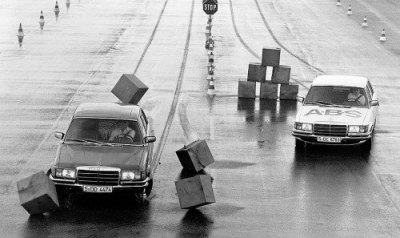 Demonstration on Mercedes S-class: the ABS-equipped car (right) successfully steered away from objects during braking. To implement anti-lock braking, ABS employs speed sensors for individual wheels. If the wheel speed detected differs considerably from the vehicle speed, that means the wheel is sliding, thus the computer will ease the corresponding brake until sliding disappear. The computer will also compare the speeds of all wheels, if one or more of them run considerably faster than others, that means the car is losing control, thus it will apply more braking to that wheel to stablize the car. Brief History ABS was first used in aircrafts to shorten landing distance. In automotive field, the first to apply ABS was the 1966 Jensen FF (also the first 4WD road car, by the way). The system, called Maxaret, was developed by Dunlop. It was purely mechanical, using mechanical sensors to avoid locking the disc brakes. Braking could be applied at most 2 or 3 times per second, so it was not quite as effective as modern ABS, which works 15-20 times a second. Anyway, road testers immediately found its superiority over conventional brakes. In the early 1970s, the Detroit big 3 and Mercedes tried the first generation electronic-controlled ABS on their cars, but the benefit was not obvious due to the ancient analogue electronics available then. Mercedes kept working on with Bosch to develop the second generation, which utilized modern integrated circuits to process data digitally. This speeded up the data processing and improved reliability a lot. The system was introduced to the S-class W116 in 1978 with great success. In the next year, Mercedes fitted it as standard to the new generation S-class W126. ABS finally entered mass production. The same Bosch ABS was also available to the first generation BMW 7-Series in 1979. By the mid-1980s, Bosch ABS expanded to cheaper cars. The 1985 Ford Granada Scorpio had it fitted as standard equipment, and it was one of the reasons to earn it the title of European Car of the Year. In USA, the 1985 Chevrolet Corvette C4 was the first America car to use Bosch ABS. Meanwhile, British supplier Lucas-Girling and AP developed low-cost ABS for cheaper cars like Ford Escort and Fiat Uno. Both served the front wheels only. Today, ABS is not only standard on all cars, but its components like wheel speed sensors, hydraulic pump and solenoid valves also serve the hardware for Traction Control, Electronic Stability Control, Torque Vectoring etc. If not ABS has become popular, these technology might not have been so widely available. Brake Assist According to the research by Mercedes-Benz, during emergency braking, 99 percent drivers fail to apply full brake pressure to the pedal. This is because most driver's feet are not strong or fast enough. Consequently, no matter how powerful the brake hardware is, collision may still happen. To deal with this problem, Mercedes introduced the industry's first BAS (Brake Assist System) to its S-class and SL-class in 1996, and made it standard to all its production cars from 1998. BAS monitors the brake pedal to judge if it is emergency braking. If yes, it signals the ABS to apply full braking pressure immediately. According to the company's research, it shortens stopping distance by 45 percent for average drivers. |
||||||||||
| Copyright© 1997-2016 by Mark Wan @ AutoZine |
